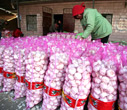Global General
Suicide bomber hits Somali graduation, 22 dead
(Agencies)
Updated: 2009-12-04 09:58
|
|
MOGADISHU, Somalia: A suicide bomber disguised as a woman has attacked a graduation ceremony in Somalia, turning a rare reason to celebrate into carnage that killed at least 22 people, including medical students, doctors and three government ministers.
Thursday's blast was blamed on Islamic militants who have shown a rising ability to carry out sophisticated large-scale bombings against high-profile targets, and highlighted the inability of Somalia's weak government to protect even the small section of the capital it controls.
"Today should have been a day of celebration, not mourning," said Somalia's ambassador to Kenya, Mohamed Ali Nur. "The hopes of many parents who eagerly awaited their sons' graduation were recklessly dashed ... cutting short the lives of ambitious Somalis."
Amateur video of the attack obtained by AP Television News showed the dead, including at least three journalists, lying in pools of blood amid the sound of wails and screams from the wounded. Soldiers, their AK-47 rifles slung over their shoulders, picked through the wreckage with their hands as survivors climbed over the debris of the bombed-out room.
The attack targeted one of Somalia's most important efforts to extricate itself from anarchy and violence, explaining the presence of so many top government officials. The graduating medical students were only the second class to receive diplomas from the medical school.
"The loss of our ministers is disastrous, but it is an outrage to target the graduation of medical students and kill those whose only aim in life was to help those most in need in our stricken country," Somali Prime Minister Omar Sharmarke said.
Before last year's graduation, almost two decades had passed since anyone earned a medical degree in Somalia. At the December 2008 ceremony, graduates proudly hoisted their diplomas into the air.
This year, there was mayhem as the bomb went off while a Somali official addressed the gathering, sending metal shards and other debris flying and leaving dead and wounded in bloody heaps.
The bomb exploded about a yard from journalists covering the event.
"The explosion occurred really close to me, about a meter away. I jumped over some of the dead people laying on the ground and I went outside," said Associated Press reporter Mohamed Olad Hassan.
"What I think is I was lucky and people who were next to me, closer to the explosion shielded me from the explosion. The explosion was still thundering in my ears when I got back to the office."
Abdul Rahman Bukhari, a reporter for the Saudi-owned Al-Arabiya television station whose colleague, cameraman Hassan Zubeir, was killed, said the bombing "was the worst moment of my life."
After the attack, overturned white plastic chairs and tables littered the floor, which was stained red with blood. A single sandal lay in a pool of congealed blood, along with a briefcase and graduation programs.
Bodies, some draped with blue cloths, lay alongside the wounded. One man in khaki pants and a white shirt sat in his own blood, twisting his head to watch as victims were dragged out of the building.
On the steps outside, a dead man lay doubled over, his head resting on the blood-soaked ground as though he were praying.
Sharmarke said it was "beneath contempt" to attack and kill students and called for urgent help from the international community to prevent the further rise of al-Shabab, a militant group with links to al-Qaida.
"What happened today is a national disaster," said Somali Information Minister Dahir Mohamud Gelle, who confirmed that the ministers for education, higher education and health were killed in the blast. The ministers for sports and tourism were among the 46 wounded, he said.
Twenty-two people were killed, along with the suicide bomber, Gelle said. The bomber "disguised himself as a woman, complete with a veil and a female's shoes," he said.
No group immediately claimed responsibility, but suspicion fell upon al-Shabab, which controls much of the country and has carried out past suicide attacks.











